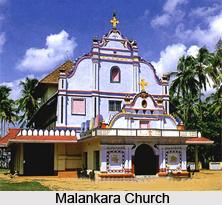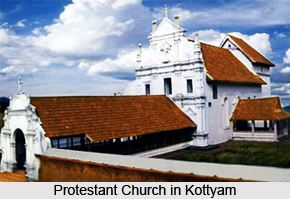Protestant Churches are concentrated in eastern and western part of India. The churches are located in West Bengal and Goa. The intrusion of Portuguese, French, British and Dutch influenced the Protestantism in Indian Society. The impact of Protestantism in India began to be felt only from the beginning of the 18th century. The three pioneering Protestant missions in India were the Tranquebar mission started in 1706 by Lutherans from Halle in Germany, which was patronized by King Frederick IV of Denmark and supported by such British associations as the "Society for the Propagation of Christian Knowledge" (SPCK) and the "Society for the Propagation of Gospel" (SPG); the Serampur mission founded by William Carrey (1793-1834) in collaboration with two other Englishmen, Joshua Marshman and William Ward; the Mission Movement started in Kolkata by Alexander Duff in 1830.
One of the notable and new features of these missions was the pride of place given to the Bible. Protestant missionaries in India had the Holy Bible translated into several regional languages of India and other East-Asian countries, and this helped to popularised the Protestantism in India. Serampur mission in Bengal gave great importance to education and journalism in the early phase of 18th Century.
 Most of the early Indian Christian missionaries, that is Baptists, Anglicans, Scottish Presbyterians, Lutherans, American Presbyterians and American Methodists, failed to identify themselves with the local people and their culture. Many of them were individualists, and thought of Christianity largely in terms of a personal experience of Jesus Christ. For some others, the Christian faith primarily was a set of beliefs that could be shown to be superior to the beliefs of other religions.
Most of the early Indian Christian missionaries, that is Baptists, Anglicans, Scottish Presbyterians, Lutherans, American Presbyterians and American Methodists, failed to identify themselves with the local people and their culture. Many of them were individualists, and thought of Christianity largely in terms of a personal experience of Jesus Christ. For some others, the Christian faith primarily was a set of beliefs that could be shown to be superior to the beliefs of other religions.
Many missionaries in the beginning were not interested in the poor or lower castes people in India. They considered themselves to be superior to the natives. The majority of Protestant Christians in India today are the ardent followers of Christian mass movements, especially in Punjab, Uttar Pradesh, Bihar and parts of West Bengal.
In the 19th century Indian society, more and more Protestant denominations from Europe and also from America began to arrive in India. The denominational differences posed great problems in a mission situation. By sheer force of necessity the various denominations formed the habit of consulting together on common problems.
Some of the early attempts resulted in the formation of a local union of Presbyterians in South India (1901), Presbyterian Church of India (1904), the South India United Church (SIUC - 1908), the Federation of Evangelical Lutheran Church in India (1926), and several other local and smaller religious unions. As a result of international ecumenical movements, in India there came into existence the National Christian Council (N.C.C.I.), a non governmental organisation in the year 1914.
Various Congregational and Presbyterian Churches which have missionary links with the United States of America., Scotland, Canada, Ireland, New Zealand, etc., came together and formed the United Church of Northern India (U.C.N.I.) in the year 1924. This new Church Organisation in the same year sent out invitations to other Protestant Churches and gave a call for organic unity in Protestantism in India.
Joint ventures in the fields of education and charity gave birth to many United Theological Colleges and also united secular colleges and charitable institutions. The Church of South India (C.S.I.) was formed in 1947. In the Church of South India., four different traditions came together: Anglican (Episcopal) Congregational, Presbyterian and Methodist. Of the Churches seeking union, the Anglican was an episcopacy ordered Church; the South India United Church, generally speaking, followed the Presbyterian model of order and worship combined with that of the Congregational Church. The Methodist Church, while having much in common with the Anglican Church from which it originated, developed a greater freedom in its worship and use of lay people in the conduct of services and in administration.
 The Scheme for Church Union for South India was, in many ways, a test case for the Church of England. It envisaged the uniting of Episcopal, Congregational and Presbyterian elements into a single Church order. The scheme received cautious approval from the Lambeth Conferences of 1920 and 1930. Many critics, especially among Anglo-Catholics, saw it as a denial of the Church`s Catholic principles in regard to the historic episcopate, the sacraments and the creeds. The formation of the Church of South India took place on September 27, 1947.
The Scheme for Church Union for South India was, in many ways, a test case for the Church of England. It envisaged the uniting of Episcopal, Congregational and Presbyterian elements into a single Church order. The scheme received cautious approval from the Lambeth Conferences of 1920 and 1930. Many critics, especially among Anglo-Catholics, saw it as a denial of the Church`s Catholic principles in regard to the historic episcopate, the sacraments and the creeds. The formation of the Church of South India took place on September 27, 1947.
Negotiations started soon after for a similar union of Churches in North India, and in 1970 the Church of North India (CNI) was born. The following six Churches came into the Church of North India:
(1) The Council of Baptist Churches in North India which professes that baptism could only be administered by immersion and to those who consciously profess their faith in Jesus Christ and also repentance of sin
(2) The Church of Brethren of India which is deeply committed to peace and opposes war
(3) The Disciples of Christ that believes in the practice of adult baptism and sees the celebration of the Lord`s supper as the central act of worship
(4) The Church of India which grew out of the work of Anglican missionary Societies
(5) The Methodist (British and Australian conferences) Church which emphasizes personal commitment to Jesus Christ, salvation through faith, holiness of life and fellowship of believers
(6) The United Church of Northern India which emphasizes preaching and the exposition of the word of God, discipline, and unity of Churches and Christians.
The history of Protestant Christianity in India assumes a significant turn from the middle of the 19th century. This period witnessed the creation of the British Empire in India, the growth of cultural renaissance in Indian society, the emergence of Indian nationalism and the final achievement of independence. For the Protestant Churches in India, this was a period of growth and expansion both in terms of numbers and in other respects.





















